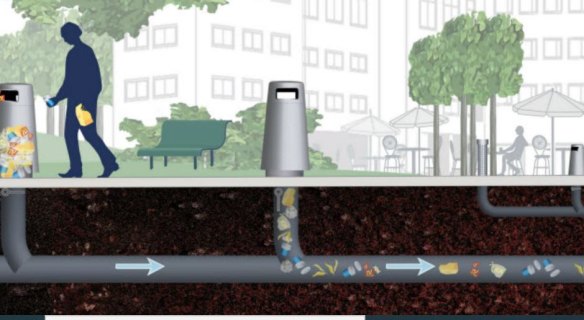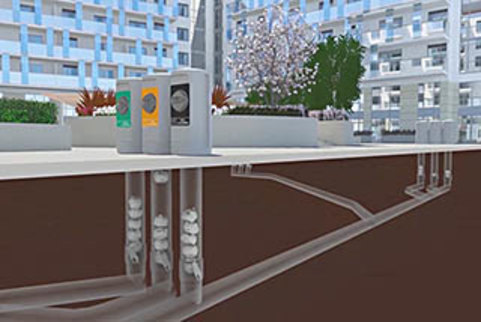This was published 4 years ago
Plan to rid Australian city of rubbish trucks almost ready to suck
By Tony Moore
The 70km/h suction whoosh of Australia’s first underground waste disposal system will replace the clanging and rattling of some rubbish trucks and wheelie bins by June.
Automated underground rubbish system are in place in cities including Stockholm, Seoul, Barcelona, London, Singapore and Beijing, but not in Australia.

An artist’s impression of an underground, vacuum-driven waste collection system being built at Maroochydore. Credit: Envac Australia.
Over the past five years, a 6.5-kilometre network of underground pipes has been placed under a section of Maroochydore, on Queensland’s Sunshine Coast, in the first phase of the innovative waste-disposal technology rollout.
It will be Australia’s first underground, automated household waste system.
In September 2016, Swedish company Envac won the contract to build the waste disposal network under 52 hectares of Maroochydore’s new, master-planned central business district.
At the time, Envac regional president Chun Yong Ha asked why Australia’s waste collection services were so far behind developments in Europe and Asia.
“My belief, based on my experience in other countries, is that our system will revolutionise waste collection in Australia,” Mr Ha said.
“And in Australia, it is rather strange that the waste collection has remained conventional for so many years.”
Last year, the COVID-19 pandemic prevented Envac specialists from travel to Australia to commission the first phase of the waste disposal system.
Now, Envac teams have arrived on the Sunshine Coast to complete their inspections of phase one.

Envac Korea senior manager Daniel Parks inspects pipes from South Korea.
A 10 metre-tall waste collection station and the first part of the underground piping, including the link from underneath the apartments and offices spaces to the nearby waste collection station, are finished.
Sunshine Coast Council planning services group executive manager James Ruprai said the Envac technical experts would assess the complete system.
“Waste and recyclables from buildings and public realm bins in the new Maroochydore City Centre will move by vacuum pressure at up to 70km/h through a 6.5-kilometre network of underground pipes to a collection station,” he said.
The vacuum would be created by a series of 110-kilowatt motors that suck recyclable and general waste to an airtight, soundproofed collection station just outside the CBD.
“The collected material will then be transferred to disposal or recycling facilities,” Mr Ruprai said.
“This innovative system will remove the need for conventional waste collection trucks to service bins on streets, which will have many benefits for traffic and amenity in the new CBD.”
Envac Australia managing director Tony Kutra said talks had been held with other Australian councils, governments and developers of larger master-planned communities.
“The idea does suit more of a precinct scale,” he said.
“There have been plenty of discussions, but there are no contracts signed.”
Mr Kutra said a second automated, suction-driven waste system would operate in Australia within the next five years.

A network of vacuum-driven pipes to collect household waste from Maroochydore’s CBD is now in place.Credit: Envac
“A greenfield site is important. Co-ordinating all services is an important aspect,” he said.
“In the Sunshine Coast case, this was very strategic because the council owned the site.
“Where you have a number of different developers owning different sections of the precinct, then joint infrastructure is just that bit more complicated.”
Mr Kutra said the businesses and governments were waiting to see what happened at Maroochydore’s SunCentral project.
“Sometimes that works for and against you,” he said.
“People like to touch and feel things.”
The Queensland government and Moreton Bay Regional Council have long considered Caboolture West, expected to be home to 60,000 people in the next 40 years, as the next cab off the rank as a regional city.
It has a 110-hectare town centre, twice the size of Maroochydore’s CBD.
“That is included in the discussions we have had,” Mr Kutra said.
“The Envac system is successful around the world and is now in more than 30 countries, so the rate of penetration tends to increase as it become a more accepted option locally.”